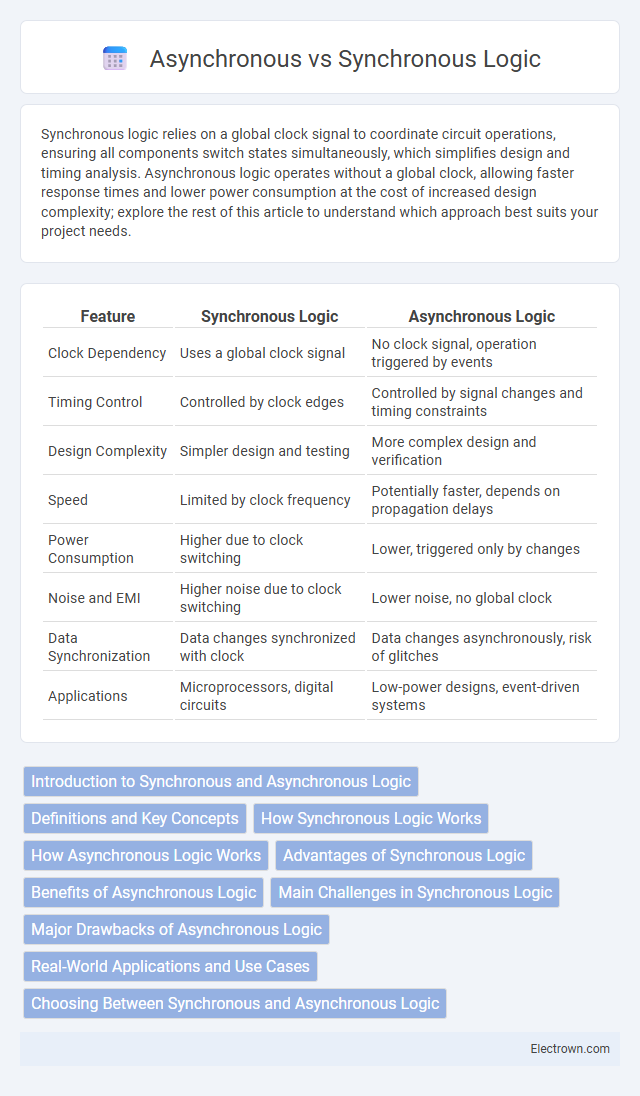Synchronous logic relies on a global clock signal to coordinate circuit operations, ensuring all components switch states simultaneously, which simplifies design and timing analysis. Asynchronous logic operates without a global clock, allowing faster response times and lower power consumption at the cost of increased design complexity; explore the rest of this article to understand which approach best suits your project needs.
Table of Comparison
| Feature | Synchronous Logic | Asynchronous Logic |
|---|---|---|
| Clock Dependency | Uses a global clock signal | No clock signal, operation triggered by events |
| Timing Control | Controlled by clock edges | Controlled by signal changes and timing constraints |
| Design Complexity | Simpler design and testing | More complex design and verification |
| Speed | Limited by clock frequency | Potentially faster, depends on propagation delays |
| Power Consumption | Higher due to clock switching | Lower, triggered only by changes |
| Noise and EMI | Higher noise due to clock switching | Lower noise, no global clock |
| Data Synchronization | Data changes synchronized with clock | Data changes asynchronously, risk of glitches |
| Applications | Microprocessors, digital circuits | Low-power designs, event-driven systems |
Introduction to Synchronous and Asynchronous Logic
Synchronous logic relies on a global clock signal to coordinate state changes across circuit components, ensuring predictable timing and easier design verification. Asynchronous logic operates without a central clock, triggering state transitions based on input changes, which can reduce power consumption and latency but complicate timing analysis. Understanding these fundamental differences is crucial for selecting appropriate digital design methodologies in complex systems.
Definitions and Key Concepts
Synchronous logic operates based on a global clock signal that synchronizes changes in the system, ensuring all components update simultaneously. Asynchronous logic, in contrast, functions without a global clock, relying on the completion of previous operations or events to trigger subsequent actions. Understanding these fundamental differences helps you design circuits optimized for speed, complexity, and power consumption.
How Synchronous Logic Works
Synchronous logic operates based on a global clock signal that coordinates changes in the state of flip-flops and registers at precise intervals, ensuring all circuit components update simultaneously. This clock-driven mechanism allows predictable timing and easy design debugging, as state transitions occur only on clock edges. Consequently, synchronous systems achieve reliable performance in digital circuits such as microprocessors and memory modules by minimizing timing-related errors.
How Asynchronous Logic Works
Asynchronous logic operates without a global clock signal, relying on handshaking and data-driven events to trigger transitions between states. This design enables circuits to process inputs and produce outputs at variable speeds, improving responsiveness and reducing power consumption. Your system benefits from asynchronous logic by achieving efficient timing and lower electromagnetic interference compared to traditional synchronous architectures.
Advantages of Synchronous Logic
Synchronous logic offers precise timing control, ensuring all circuit elements operate in harmony with a global clock signal, which minimizes timing errors and simplifies design verification. This predictability enhances reliability and facilitates easier debugging and testing processes. Your digital systems benefit from consistent performance and easier scalability due to the inherent synchronization of all components.
Benefits of Asynchronous Logic
Asynchronous logic offers significant benefits such as lower power consumption and reduced electromagnetic interference due to its event-driven operation. It improves speed and performance in systems by eliminating the need for a global clock, allowing circuits to operate only when necessary. Your designs can achieve increased robustness and flexibility, especially in handling variations in process, voltage, and temperature.
Main Challenges in Synchronous Logic
Synchronous logic faces significant challenges including clock skew, which causes timing mismatches across different parts of the circuit, and setup and hold time violations that threaten data stability and reliability. The global clock distribution network consumes substantial power and area, complicating design in large-scale integrated circuits and limiting scalability. Addressing these issues is critical for ensuring your system's timing integrity and overall performance in synchronous designs.
Major Drawbacks of Asynchronous Logic
Asynchronous logic circuits suffer from major drawbacks such as increased design complexity and difficulty in timing analysis due to the absence of a global clock, leading to potential race conditions and hazards. These challenges often result in unpredictable behavior and higher susceptibility to noise and glitches, complicating verification and testing processes. Your system's reliability may be compromised without precise synchronization, making asynchronous logic less practical for many mainstream digital applications.
Real-World Applications and Use Cases
Synchronous logic is widely used in microprocessors, digital clocks, and communication systems where precise timing and coordinated data transfer are critical for performance and reliability. Asynchronous logic excels in low-power devices, event-driven systems, and applications requiring high-speed data processing without a global clock, such as certain network routers and sensor interfaces. Your choice between synchronous and asynchronous designs should consider the specific timing, power consumption, and complexity requirements of your application.
Choosing Between Synchronous and Asynchronous Logic
Choosing between synchronous and asynchronous logic hinges on design complexity, speed requirements, and power consumption. Synchronous logic, driven by a global clock signal, offers predictability and ease of debugging, making it suitable for large-scale integrated circuits and microprocessors. Asynchronous logic, free from clock dependency, enables lower power usage and reduced latency, benefiting applications requiring high-speed data processing and low electromagnetic interference.
Synchronous vs Asynchronous Logic Infographic

 electrown.com
electrown.com